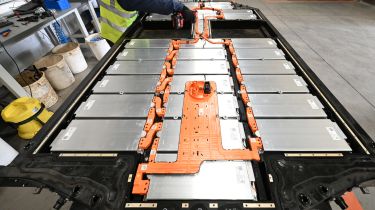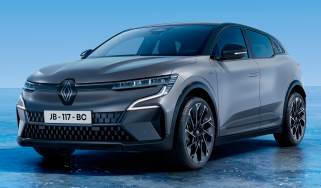What are solid state batteries? Future electric car tech explained
You might have heard about solid-state batteries in future electric cars, but what are the benefits?

Like nuclear fusion, solid state batteries are one of those technologies that seem to be “just around the corner”, yet constantly five or ten years from the mainstream. Also like nuclear fusion however, there’s a good reason that solid state battery technology is still being pursued, since it would represent a significant advancement over the battery technology we currently have.
Put simply, solid state batteries have the potential to be smaller, lighter, less volatile, and more energy-dense than existing “liquid” batteries, which has huge implications for electric cars. Think improved packaging, lighter weight, faster and safer charging, and the big one, longer range.
But what are solid state batteries? Below, we look at existing battery technology, and then how solid state is expected to improve upon it – and how long you might have to wait before driving around in a car with solid state batteries slung underneath it.
How does a battery work?
A battery is a way of converting chemical energy into electrical energy, by inducing a flow of electrons between two electrodes (an anode and a cathode) through a circuit. Between these two electrodes though is an electrolyte – a chemical solution that causes a reaction with the anode to create electrons, and at the cathode to be able to accept electrons. Since an electrical circuit gives these electrons a handy pathway between anode and cathode, the battery generates electricity that can be used to power… well, basically anything.
Current battery technology
A surprising number of materials and solutions can function as an electrolyte. At school, you may well have built a potato or lemon battery at some point, using zinc and copper electrodes, with a piece of wire and a small lightbulb between them to demonstrate a full electrical circuit.
To power any more than a tiny LED though, the electrolyte and electrodes need to be a little more sophisticated, and if you want to use the battery more than once, it needs to be rechargeable too. The most familiar kind of rechargeable battery for most of the 1900s was the lead-acid battery, where the electrodes are made from lead and lead dioxide, and the electrolyte is diluted sulphuric acid. Lead-acid batteries are heavy but reliable, cheap, almost endlessly recyclable, and are still used in almost every modern car (including a lot of EVs) as a 12-volt starter battery.
Before electric vehicles hit the mainstream, huge banks of lead-acid batteries were often used to power earlier attempts at EVs, though their weight, low energy density, and slow charge and discharge cycles tended to make these cars slow to drive, with low range, and slow charging times.
When Toyota introduced the Prius hybrid in the late 1990s, it used nickel-metal hydride batteries for the car’s electric running, which proved reliable and also quick to charge and discharge. This was ideal for a hybrid car, where assist and regeneration cycles place constant demand on the battery.
Lithium-ion technology has become the primary battery tech used in electric cars though. These use a lithium salt dissolved in a solvent, polymer or a gel as the electrolyte, with the anode and cathode material changing depending on the application. The principle on which they operate is much the same as any other battery, but lithium batteries have proven ideal for most of modern life’s appliances, from phones to cars, since they are relatively energy-dense, last a relatively long time, and can be charged relatively quickly.
You’ll note the word “relatively” in each of these, since there’s still always room for improvement, and lithium batteries aren’t without their drawbacks either. Despite rapid advancement in recent decades, they remain expensive, do degrade over time and usage cycles, and still don’t have energy density even close to the same weight in fossil fuels. This is why cars use absolutely huge batteries weighing hundreds of kilos just to match the range of a car with a small fuel tank.
They can also be thermally unstable if incorrectly charged or damaged, and there are still environmental question marks over the mining, processing, and manufacturing of lithium and other metals used in batteries – though as ever, this must be weighed against the impact of fossil fuel production and use, which is hardly squeaky-clean itself.
Solid state battery technology
That’s where solid state battery technology comes in. These batteries are once again the same as any other in principle, but use a solid state electrolyte rather than the usual solvent or gel. Current technology remains focused on lithium, so the solid electrolyte can, in theory, be any material that allows lithium ions to pass through, causing the required chemical changes to the anode and cathode. Battery companies are exploring everything from metals, through ceramics, to special types of glass to act as the solid electrolyte.
Solid state batteries are already in use in some small consumer devices, as well as medical implants, but scaling them up has so far proven very difficult. Difficult tends to mean costly, and given that batteries are already expensive for their energy density, it’s why we’ve not even seen the technology in everyday devices like smartphones just yet – technology giant Samsung only expects to release its first solid state smartwatch in 2026, let alone a phone or laptop, to give you an idea of the timeline.
Why do solid state batteries matter for electric vehicles?
The primary advantages of solid-state batteries are energy density, greater resistance to changes in temperature, and safety. So you can see instantly why car manufacturers are clambering over each other to bring a solid state battery electric vehicle to market.
Increased energy density has benefits in just about every way that matters for an electric car. Being able to pack more energy into the same space means cars with big batteries can go ever further on a charge – but also means cars with smaller batteries can go as far as those with big batteries do today. Charging is quicker too, so you could shrink batteries even further on the basis that stopping to charge won’t take as long.
In turn, being able to reduce the size of a battery pack while getting the same range has a knock-on effect for weight and packaging. Less weight reaps benefits across the dynamic spectrum (like for like, a lighter car should ride, handle, go, stop, and steer better than a heavier one) but also means companies can reduce the weight of other components too, since they don’t need to carry so much weight. That starts a virtuous circle, since a lighter car also requires less energy to move, making it more efficient.
Likewise, a smaller battery means more space for passengers and luggage. A solid state battery may not need to be as thick as the ones in current cars, so you can use that space in the cabin – or reduce the height of the vehicle for better aerodynamics. There’s the potential for better styling, too, since unlike today designers may not have to incorporate a big six-inch slab of batteries into a car’s proportions.
Early research suggests solid state batteries aren’t as susceptible to changes in temperature as existing technology, which means less range drop-off in cold conditions, and less performance degradation when it’s hot. And talking of getting hot, research has also shown that when things go wrong, solid state batteries are less susceptible to thermal runaway, where a failing battery, through damage or other causes, won’t catch fire and start a chain reaction of other cells also catching fire.
When will we see solid state batteries in cars?
Ah, if only we knew. Toyota has been experimenting with the technology for more than 15 years but says it doesn’t expect to put a vehicle using them into production until 2027 – and that date has already slipped a couple of times.
MG expects to launch a “semi” solid-state battery in a car in the Chinese market in 2025 – a nebulous term which features, as you might imagine, a “semi-solid” polymer electrolyte, rather than the liquid or gel of a regular battery and the solid electrolyte of a solid-state one. Among other benefits, it’s expected to offer a driving range of more than 600 miles from a 133kWh pack, though if you do the maths, efficiency of around 4.5mi/kWh is hardly groundbreaking. 400kW charging, for around 250 miles of range in 12 minutes, is more intriguing.
Stellantis meanwhile is expected to test more semi-solid-state batteries in a fleet of Dodge Charger electric muscle cars in 2026, though again we’ll believe this when we see it.
In other words, fully solid-state batteries may still be a good few years away from the mainstream. Perhaps not as far as nuclear fusion, but don’t hold your breath if you’re waiting for better technology to arrive before you make that electric vehicle purchase.
Buy a car with Auto Express. Our nationwide dealer network has some fantastic cars on offer right now with new, used and leasing deals to choose from...
Find a car with the experts





